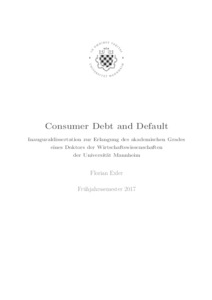|
Consumer debt and default
Exler, Florian
![[img]](https://madoc.bib.uni-mannheim.de/43186/1.hassmallThumbnailVersion/Dissertation_Exler.pdf)  Vorschau |
|
PDF
Dissertation_Exler.pdf
- Veröffentlichte Version
Download (1MB)
|
|
URL:
|
https://madoc.bib.uni-mannheim.de/43186
|
|
URN:
|
urn:nbn:de:bsz:180-madoc-431863
|
|
Dokumenttyp:
|
Dissertation
|
|
Erscheinungsjahr:
|
2017
|
|
Ort der Veröffentlichung:
|
Mannheim
|
|
Hochschule:
|
Universität Mannheim
|
|
Gutachter:
|
Tertilt, Michèle
|
|
Datum der mündl. Prüfung:
|
8 August 2017
|
|
Sprache der Veröffentlichung:
|
Englisch
|
|
Einrichtung:
|
Fakultät für Rechtswissenschaft und Volkswirtschaftslehre > VWL, Makroökonomik (Juniorprofessur) (Lee 2011-2016)
Fakultät für Rechtswissenschaft und Volkswirtschaftslehre > Makro- u. Entwicklungsökonomie (Tertilt 2010-)
Außerfakultäre Einrichtungen > GESS - CDSE (VWL)
|
|
Fachgebiet:
|
330 Wirtschaft
|
|
Fachklassifikation:
|
JEL:
E21,
E43,
E44,
K35,
|
|
Normierte Schlagwörter (SWD):
|
Konsumentenkredit , Insolvenz , Schuldenerlass
|
|
Freie Schlagwörter (Englisch):
|
Unsecured Debt , Personal Bankruptcy , Delinquency , Default , Garnishment
|
|
Abstract:
|
This dissertation comprises three self-contained essays in which I analyze the effects of consumer bankruptcy laws on household borrowing, interest rates, default decisions, and welfare in different institutional settings. Chapter 2 analyzes whether and how to regulate small dollar lending in the U.S. I show that lump-sum court filing fees prevent low-income households from filing for bankruptcy, causing them to become delinquent. In a policy experiment, I show that easier access to bankruptcy increases welfare of this group by 1%. Chapter 3 evaluates the German bankruptcy system, which features relatively harsh wage garnishment. Since wage garnishment raises the effective marginal tax rate, it exhibits adverse effects on labor supply. Explicitly modeling labor supply, this paper documents the optimal garnishment regime for the German economy: garnishment rates are reduced by more than 25%, while the duration of garnishment is increased from six to ten years. This results in an aggregate welfare increase of around 3.3%. Chapter 4 is joint work with Igor Livshits, James MacGee, and Michèle Tertilt. There is increased debate over whether the regulation of unsecured consumer lending products is required to protect some consumers from “over-borrowing.” To assess the quantitative benefits of regulating the cost of declaring consumer bankruptcy, we analyze a life-cycle model where some consumers have excessively optimistic beliefs about their exposure to unforeseen expenses.
|
 | Dieser Eintrag ist Teil der Universitätsbibliographie. |
 | Das Dokument wird vom Publikationsserver der Universitätsbibliothek Mannheim bereitgestellt. |
 Suche Autoren in Suche Autoren in
Sie haben einen Fehler gefunden? Teilen Sie uns Ihren Korrekturwunsch bitte hier mit: E-Mail
Actions (login required)
 |
Eintrag anzeigen |
|
|
